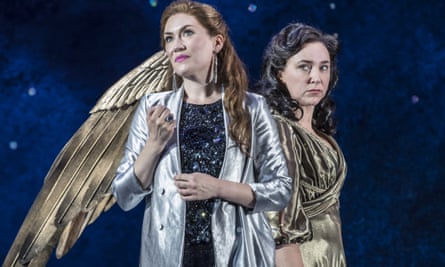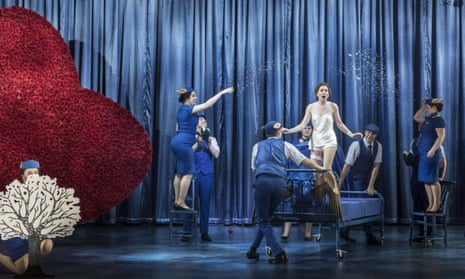Annilese Miskimmon’s sardonic new production of Semele reimagines Handel’s parable of desire and ambition as a romcom that turns increasingly malign and surreal. Nicky Shaw’s designs, awash with cinematic allusion, suggest the early 1960s: our awareness of the impending sexual revolution consequently heightens the clash between rebellious amorality and social and familial convention.
Heidi Stober’s Semele seemingly becomes a member of the mile-high club when Robert Murray’s sensualist Jupiter whisks her away from her posh wedding – straight out of High Society – and installs her in a lunar boudoir where the “Loves and Graces” that attend her are smartly uniformed cabin crew. Christine Rice’s resentful Juno, mother of Jupiter’s seven children, plots revenge from her maternity ward bed while giving birth to an eighth, as David Soar’s Somnus supplies her with gas, air and painkillers. Semele’s eventual comeuppance, meanwhile, is nastily reminiscent of Ursula Andress’s demise in She.
There is, however, an uncertainty of tone. Miskimmon’s harsh humour sometimes flies in the face of the wit and subtlety of William Congreve’s 18th-century text, and the staging is at its strongest when her imagery takes second place to psychology. The emotional havering between Christopher Ainslie’s Athamas and Jurgita Adamonytė’s Ino – Semele’s rejected bridegroom and the bridesmaid who adores him from afar – is breathtakingly done. Stober’s final showdown with Murray really grips with its tension and irony.

There’s some beautiful singing. Stober, all creamy tone and gleaming high notes, finds some of the coloratura tricky towards the end, though Oh Sleep, Why Dost Thou Leave Me sounds exquisite. Murray, suavely persuasive throughout, really beguiles with Where’er You Walk. Ainslie and Adamonytė are profoundly touching together, though Rice, in superb voice, nearly steals the show with her rage and thrilling low notes. Jonathan Cohen conducts with infinite grace, and the choral singing is outstanding – nowhere more so than in the second act finale, where Handel briefly pauses to contemplate the music of the spheres before the drama escalates towards catastrophe.

Comments (…)
Sign in or create your Guardian account to join the discussion